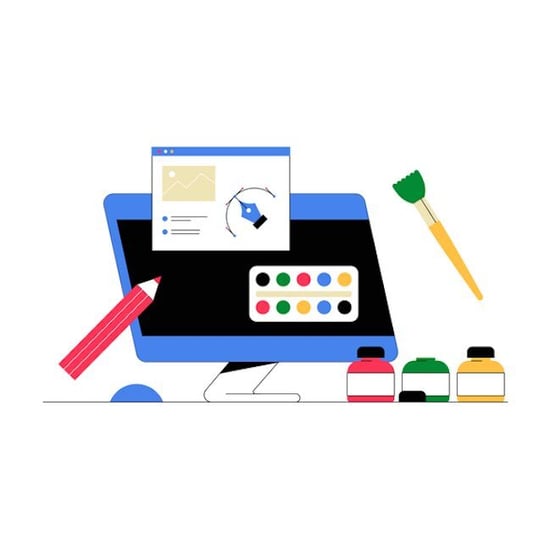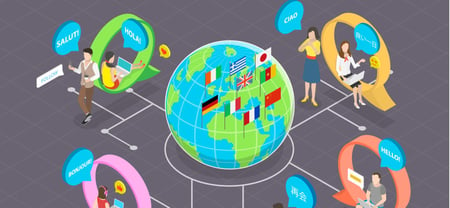How to Adapt Visual Content for Different Markets in Localization

When localizing content, it’s easy to just consider your text and forget that localizing your visual content is just as important as translating your words.
From social media graphics and website imagery to product packaging and instructional videos, visuals play a powerful role in how your message is received by international audiences.
As a Language Service Provider (LSP), we usually have to consider imagery and graphics in localization strategy. It’s important to stress that visual localization isn’t just about changing text on an image.
It's a nuanced process that requires understanding cultural norms, visual preferences, and even technical constraints.
So where do you start and what do you have to consider? Here’s what we suggest you consider when adapting your visual content for localization.
Cultural Relevance and Sensitivity
Every culture has its own symbols, color meanings, fashion, gestures, and visual humor. What’s considered appealing or neutral in one culture might be offensive or confusing in another.
- Colors — For example, red can signify luck in China, but danger or warnings in Western cultures. White is associated with purity in the West but is a mourning color in parts of Asia.
- Icons and symbols — A checkmark might mean “correct” in the U.S., but in countries such as Finland, Sweden, and Japan, it means “wrong”.
- People and clothing — Showing people with culturally specific clothing or physical features can help local audiences relate to the content. However, do your research and be mindful not to stereotype or misrepresent.
Before rolling out visuals in a new region, consult with local experts to ensure that imagery works for that particular culture.
Text in Images
One of the most overlooked aspects of visual localization is embedded text. These are words that are part of an image file rather than separate, editable layers.
- Translatability — Text embedded in images needs to be extracted, translated, and then reinserted into the graphic. This process can be time-consuming and it’s easy to make errors if you don’t plan for it correctly.
- Space constraints — Different languages vary in length. A short English word may become a much longer phrase in German or Finnish, potentially disrupting your design layout.
- Font support — Ensure that the fonts used support all character sets, including accents, special characters, or entirely different scripts like Arabic, Chinese, or Hindi.
To future-proof your visuals, use layered design files (like Adobe PSD or AI formats) so that adapting them into a new language is a straight-forward process.
Visual Hierarchy and Reading Direction
Reading habits vary across cultures. While English is read left to right (LTR), languages like Arabic and Hebrew are read right to left (RTL). Naturally, this impacts how visuals should be arranged.
- Layout adjustments — Interfaces, infographics, and even illustrations may need to be mirrored or rearranged to align with RTL reading logic.
- Visual flow — Arrows, sequencing graphics, and animations should guide the viewer’s eye naturally according to their reading direction.
Designing flexible layouts from the start makes these changes smoother when you begin localizing.
Use of Faces and Emotions
Facial expressions and body language are not universally interpreted the same way. A thumbs-up gesture might mean “great” in many countries, but it's offensive in some parts of the Middle East and West Africa.
Similarly, smiling might be seen as a sign of friendliness in the U.S., but in some East Asian countries, it can be a mask for discomfort or sadness.
When using human imagery to convey emotion or intent, ensure that the expressions are culturally appropriate and won't be misunderstood.
Legal and Regulatory Compliance
Some visuals may need to be altered, or even removed entirely, to comply with local laws or industry regulations.
- Product labels — Ingredients, disclaimers, or safety icons may be required to appear in certain ways in different countries.
- Depictions of certain content — Images of alcohol, religious symbols, or even animals can be restricted or considered taboo in some markets.
- Children and privacy — Countries like Germany and France have strict laws regarding the use of children's images in advertising.
Consult with legal teams or localization partners to ensure all visual content complies with local regulations.
Technical Compatibility
Different regions may use different platforms, screen resolutions, or media formats.
- File sizes — In areas with slower internet speeds, such as many areas in North and sub-Saharan Africa, heavy image or video files may hinder user experience.
- Platform standards — Social media platforms popular in the West (like Instagram or Facebook) might not be as dominant elsewhere. In China, for instance, WeChat and Weibo have different design specs and image formats.
Always optimize visuals for the target market’s preferred devices and channels.
Testing and Feedback
Localization isn’t complete without user feedback. Before launching at scale make sure you:
- Test with local audiences — Run focus groups or A/B tests with native users to see how visuals are received.
- Get feedback from local teams — Collaborate with regional marketers or in-market teams who understand the subtleties you might miss.
Refine your visuals based on real user input to give your brand a better chance of gaining local traction.
Consider Everything For Success
A lot can fall through the cracks when it comes to visual localization, so make sure you consider everything and find an experienced team to support you.
One who will help you take the time to understand your target culture’s visual language, so your content hits the mark and makes an authentic connection. After all, a picture is worth a thousand words, but only if it’s speaking the right language.
Are you expanding into a new market and need help with localizing your content? If so, we’d love to talk to you. Consultations are free and there’s no obligation.
You’re in safe hands with us as we’re ISO 17100 and ISO 9001 compliant, have over twenty years of professional translation experience, and have earned the trust of organizations around the world.






